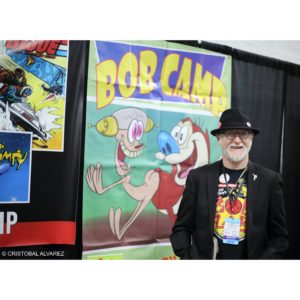Podcast: Play in new window | Download
Subscribe: Apple Podcasts |
 Bob Camp is a cartoonist and cartoon developer who co-created the iconic Ren and Stimpy Show. He worked for Rankin Bass, Marvel Comics, Warner Brothers and has worked on numerous well-known animation projects. He currently teaches Visual Arts in NYC. I spoke to him about his past work, inspirations, process and future goals at the 2018 Great Philadelphia Comic Con.
Bob Camp is a cartoonist and cartoon developer who co-created the iconic Ren and Stimpy Show. He worked for Rankin Bass, Marvel Comics, Warner Brothers and has worked on numerous well-known animation projects. He currently teaches Visual Arts in NYC. I spoke to him about his past work, inspirations, process and future goals at the 2018 Great Philadelphia Comic Con.
1:26 – Bob Camp got into animation in the 1980s while working at Marvel Comics. He started with Thunder Cats and other Rankin Bass shows. Then he moved to LA to do animation full-time when Rankin Bass closed down.
3:29 – Bob isn’t an animator and is self-taught in everything he does. He considers himself too lazy for animation. He studied film in school and then did caricatures and portraits for rodeos and such. He met Gary Holgren who got him into comic art for Marvel Comics. He inked for John Buscema and then was doing fixes on just about every Marvel comic while he was there.
6:18 – In LA, he worked for the studio Deke who [doing] did Captain Planet and Inspector Gadget. Bob worked on an animated Alf series and then a Ghostbusters piece.
7:35 – Then he began working on Tiny Toons for Warner Brothers. He began doing other work and then worked on Your Gang and Ren and Stimpy were minor characters in that show. Then they teamed up with Nickelodeon and began doing their cartoon show. Ren and Stimpy started as a theatrical cartoon.
10:59 – Bob was inspired by the cartoons from the 1940s that were created for theatrical release. Those cartoons were for entire families.
13:44 – The reboot of Ren and Stimpy poisoned the well of the original series. Ren and Stimpy could have gone on for a longer time if it hadn’t had the troubles they had.
15:59 – Bob is an actor and did a bunch of the voices for Ren and Stimpy. He’s in the Screen Actors Guild. His favorite part of creating cartoons is the development. He likes show running too. He also likes to fix scrip ideas.
18:09 – Bob teaches at the School of Visual Arts in NYC. He teaches storyboard creation and critiques his students’ work as if he were the director. He likes taking ideas and making them better.
20:20 – Bob likes using Pinterest to inspire himself. The images there give him new ideas.
22:19 – The comic business is tough though. It’s a hard and stressful life which you need to love.
23:49 – He’s been inspired by Bob Camplett, Chuck Jones, Tex Avery, Harvey Kurzman, and a slew of others. He loves the Three Stooges.
25:19 – Comics are an incubator business for movies. The artists don’t make the money. The studios and the executives make the money.
27:43 – Bob has a sci-fi epic project he’d love to do. He has a little kid show that takes place in New York he’d like to do. He has lots of ideas and plenty of sketches.
28:59 – Bob said the way to succeed in this business is to just start making films and don’t wait for money. Get a youtube channel, teach yourself the skills you need. Do it yourself. You don’t need college.
30:17 – He’s on Bob Lab Studios on facebook and instagram. Michelle Fire is his partner and she has sites on facebook and instagram.
Links of interest
https://www.facebook.com/boblabstudios/
https://boblabshop.com/
http://boblabstudios.com/
https://twitter.com/boblabstudios?lang=en
https://twitter.com/michelefire
For more of the podcast “The Art and Design of Sci-Fi and Fantasy, Mystery and Horror” please follow me on Facebook at crisalvarezwlc, on youtube at Cris Alvarez and on Instagram @crisalvarezscifi
Guest: Bob Camp
Host: Cris Alvarez
Tags: cartoon, art, animation, rankin bass, ren, stimpy, nickelodeon, marvel comics, john buscema, ghostbusters, alf, tiny toons, crazy


 Bob Camp is a cartoonist and cartoon developer who co-created the iconic Ren and Stimpy Show. He worked for Rankin Bass, Marvel Comics, Warner Brothers and has worked on numerous well-known animation projects. He currently teaches Visual Arts in NYC. I spoke to him about his past work, inspirations, process and future goals at the 2018 Great Philadelphia Comic Con.
Bob Camp is a cartoonist and cartoon developer who co-created the iconic Ren and Stimpy Show. He worked for Rankin Bass, Marvel Comics, Warner Brothers and has worked on numerous well-known animation projects. He currently teaches Visual Arts in NYC. I spoke to him about his past work, inspirations, process and future goals at the 2018 Great Philadelphia Comic Con.